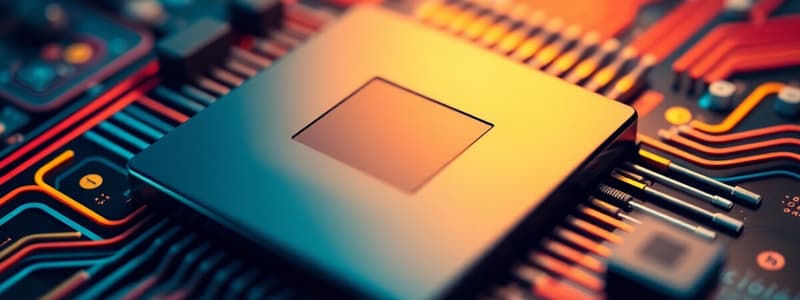Podcast
Questions and Answers
What is the grading percentage for the Mid-Semester Examination?
What is the grading percentage for the Mid-Semester Examination?
- 25%
- 20%
- 10%
- 15% (correct)
Which of the following is NOT a component of the evaluation?
Which of the following is NOT a component of the evaluation?
- Class Participation (correct)
- Project
- Assignments
- Quiz
What are the two types of digital programmable systems?
What are the two types of digital programmable systems?
General purpose systems and special purpose systems
The range for grade A is ___ marks.
The range for grade A is ___ marks.
Match the following components with their descriptions:
Match the following components with their descriptions:
Continuous variables have a finite number of possible values.
Continuous variables have a finite number of possible values.
What is the quantization step formula?
What is the quantization step formula?
According to the Nyquist theorem, what is the condition for sampling frequency?
According to the Nyquist theorem, what is the condition for sampling frequency?
Flashcards are hidden until you start studying
Study Notes
Course Overview
- Introduction to various number systems, microprocessors, and their applications in real-time systems.
- Integrated Development Environment (IDE) will be explored alongside programming practices.
Evaluation Components
- Mid-Semester Examination accounts for 15% of the final grade.
- End Semester Examination contributes 25% to the overall evaluation.
- Assignments, quizzes, weekly reports, and a project each constitute 15% of the final mark.
Grading System
- Absolute grading system with specific ranges for letter grades.
- Grades range from A (90-100) to NP (0-29).
Digital Electronic Circuits
- Digital circuits classified into non-programmable (e.g., logic gates, flip-flops) and programmable circuits (e.g., microprocessors).
- Strong emphasis placed on understanding programmable circuits.
Digital Programmable Systems
- Two categories: general-purpose systems (e.g., laptops, desktops) and special-purpose systems (e.g., washing machines, mobile devices).
- Focus on foundational concepts of special-purpose systems.
General Algorithm
- Process consists of reading input, processing it, generating control signals, displaying results, and looping back to read input again.
Continuous vs. Discrete Variables
- Discrete variables used for computer processing; continuous variables have infinite potential values (e.g., temperature, distance).
- Discrete examples include counts of objects; they are represented as finite numbers.
Analog to Digital Conversion
- Continuous variables must be converted to discrete formats for computer processing.
- Signals defined as functions of time, and must be converted into electrical signals via sensors.
Types of Signals
- Analog Signal: Characterized by continuous amplitude and time (CA/CT).
- Digital Signal: Defined by discrete amplitude and time (DA/DT); often produced by analog sensors and converted using Analog to Digital Converters (ADC).
ADC Operations
- Sampling process converts analog signals (CA/CT) to digital form (CA/DT).
- Nyquist theorem necessitates a sampling frequency (fs) of at least double the maximum frequency (fmax) of the signal to avoid aliasing.
Examples of Sampling Frequencies
- Speech signal sampled at 8 Ksamples/s with a fmax of 3.5 KHz.
- Sound signal sampled at 48 Ksamples/s with a fmax of 20 KHz.
Sampling Process
- Utilizes a multiplier where an analog signal is combined with a periodic pulse train.
Quantization
- Converts continuous amplitude into discrete amplitudes, defined mathematically.
- Formula for quantization step (q): q = (Vmax – Vmin)/(2^n), where n is the number of bits used.
Encoding
- Encoders convert quantized amplitudes into binary values for efficient digital representation.
- The binary system is preferred due to its efficiency in using only two stable voltage levels.
Benefits of Binary Encoding
- Requires fewer stable levels compared to decimal systems.
- Reduces the effect of noise, which is crucial for long-distance signal transmission.
- Facilitates easier processing through Boolean logic in circuits.
Studying That Suits You
Use AI to generate personalized quizzes and flashcards to suit your learning preferences.





